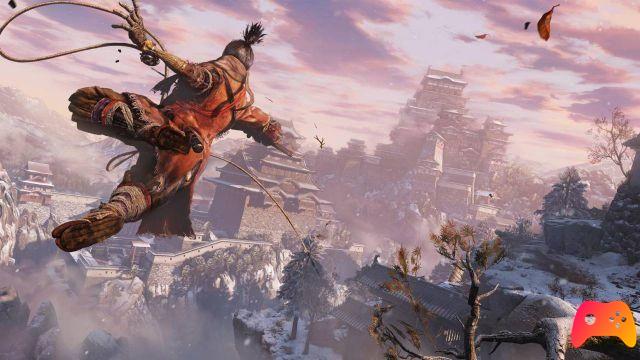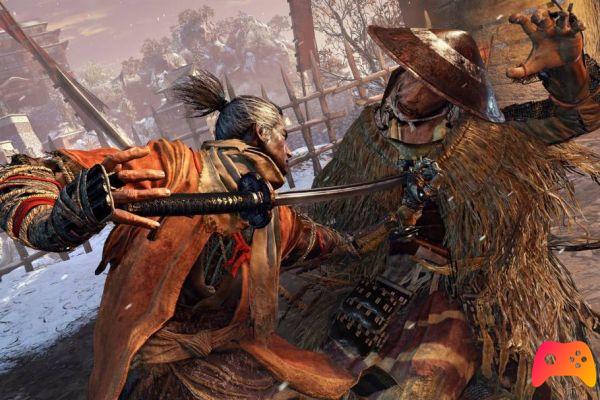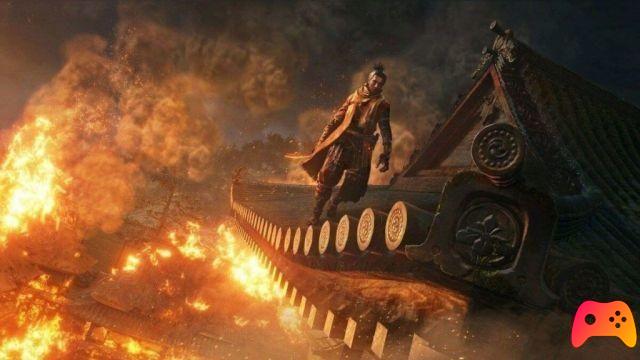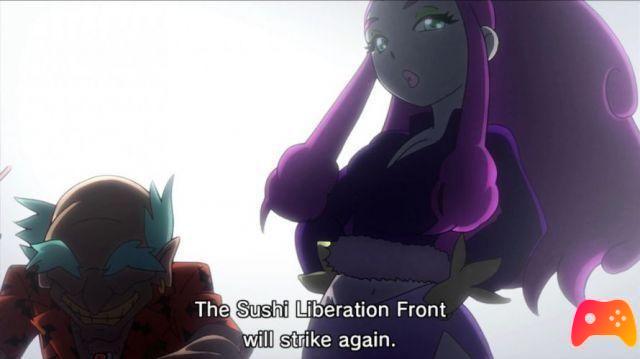
Review for Sekiro: Shadows Die Twice. Game for PC, PlayStation 4 and Xbox One, the video game was released on 22/03/2019
Fidelity, honor and fortitude are hard virtues to keep alive. In a country tormented by wars, clashes and injustices, an act of kindness, of generosity, can give life to a diamond in its rough state which, over time, will become an immortal shinobi, in every sense. The aspiration of FromSoftware with the release of Sekiro: Shadows Die Twice it is precisely that of giving the gaming scene a new gem, a new diamond, after the efforts and great results achieved with the Souls. With Sekiro many things change: from the setting to the narrative, from the combat system to the way of conceiving the main character, but Miyazaki's signature remains clearly visible to those who have had the opportunity to know his past creations.
FromSoftware's last son has his own identity, he detaches himself from his older brothers but is no stranger to the family: Sekiro is a title that has a lot to say, a lot to prove and above all a lot to teach. Starting the title you will live a different, alternative game experience, where resurrection after death (or death after death if you prefer), you will begin to enter a sort of mental state with no middle ground: either you reach a higher level, ascending to nirvana or rush straight to hell, in a spiral of death and resurrection that will never end.

A life on the cutting edge
When it comes to FromSoftware, pointing out that the concept of death plays a fundamental role in its latest title is now Pulcinella's secret. Sekiro does not escape this trend and certainly does not want to make a mystery of it, so much so that death resides in its very name. Many may be skeptical of yet another title set in the Sengoku era, with shinobi, noble lords and katanas. It's easy to fall into clichés and fall into the same old story of blood, metal and death. Well Sekiro has all three elements mentioned but the mix with which he proposes them has that I don't know what that will capture you, that aura of mystery that will lead you to face many (but really many) hardships and enemies, in order to have a piece more to add to the puzzle.
The opening words are very simple: the Wolf, a shinobi who has sworn allegiance to his lord Kuro, must save the latter after he has been kidnapped for reasons that are initially not very clear. Just at the moment when everything seems to be turning in the right direction, with his lord at his side, the Wolf loses not his fur but a fundamental clash, along with his left arm. It will be precisely when he awakens that everything will begin to take a strange fold, different from the usual, where the spiral of blood and death will begin, ending up capturing you and not letting go, for many, many hours.

The narrative is different than in the past, more explicit but no less interesting in comparison to the Dark Souls saga. The dialogues and cutscenes will be much more numerous and rich, making us immerse ourselves perfectly in the game world. Japan's surrender of the Sengoku era, which obviously winks at classic oriental myths, is certainly to be acclaimed and rewarded. Nothing is missing, both from a visual and narrative point of view, within the realization of a deep and well-characterized game world, thanks also to its characters.
Miyazaki does not fail to insert his personal lesson in the face of the concepts of death and eternal life, rotating the whole title on these pivots, demonstrating how the will of man can be corrupted and bent in front of the promise of power. The father of Dark Souls then manages to tie everything also with the political aspects and values of the time, adding more value to the already convincing narrative of his creation.

It is born, grows, runs, dies, rises again
Sekiro: Shadows Die Twice is obviously not exempt from the trait that now distinguishes almost all the works of FromSoftware, the difficulty, indeed it becomes perhaps the greatest exponent. The duels will put a strain on our nerves, reflexes and our temper reaching levels higher than those of the Souls but strangely without frustrating too much: Sekiro's combat system rewards both technical skill and strategy, the wise use of skills mixed with that of items, and it does not fail to offer an option for retreat in which there will be absolutely no shame. Being guided by anger and haste is a way like any other to end up being the victim of the lashes of enemies, ending up stuck in the same spot for hours.
To progress in Sekiro it will be necessary to immerse yourself in the shoes of the shinobi, acquiring the phlegm and steadfastness of the Japanese warrior, in a world where a false step dictated by fury could mean certain death and it does not matter if we are given the chance to rise again. . When we engage an enemy, nothing else exists: only his katana and ours, ready to merge into a deadly dance. With this we are certainly not saying that Sekiro will become a walk in the park, far from it: you will die a lot of times but, in each of these, you will learn something, you will improve yourself and then get back on track with the right mood to take home the victory.

Sekiro immediately makes everything clear, exposing the basics of the combat and development system through quick tutorials in a gradual manner. However, what is visible right after the first hours of the game is the difficulty curve which has a substantial surge when facing not only the bosses but also the mini-bosses. These will sometimes prove even more difficult than the first, taking away attempts after attempts, when instead we will overcome the sections with the "standard" enemies in a much simpler way. In any case, each challenge will have its own reason, its intrinsic value, ending up being remembered and fixed in the player's mind, especially if we are talking about lovers of challenges.
Much of the merit and value represented by Sekiro goes to the combat system, deep and well structured but not too complex for this. As mentioned earlier, the combat system was designed to reward quick reflexes mixed with a pinch of strategy. Forget about the slew of stats and parameters of Dark Souls, here we turn to more. You will really improve, rather than Sekiro. In any case, you can only count on three parameters: Strength, Posture and Vitality. The first is increased only after beating the bosses, at the Sculptor's Idols (the equivalent of the Darksoulsian Bonfires) while for the other two statistics they will be improved through special objects, the rosary beads. Among the three parameters, the most “revolutionary” if we want to call it that is Posture. This in fact plays a fundamental role in the fighting economy: both the Wolf and all his opponents will have a posture bar that can be assimilated to a sort of "armor" to be broken to inflict the Deadly Blows, that is the real attacks with which we will seriously damage the opponent's Vitality and bring home victory.
The difficulty lies in the fact that the enemies' Posture bar will go emptying if we do not attack consistently and the possibility of inflicting Killing Blows will be given only when this bar is full: this mechanic means that the clashes are spectacular and rich action, as no one will want to give up to win, neither us nor the enemy. To add further to the pepper clashes will be the classic parry of Soulsian memory, in fact in Sekiro we will be able to perform the Deviations parrying the enemy attacks at the right time, being rewarded with the possibility of inflicting Deadly Blows by ignoring the Posture. Everything therefore revolves more around the perfect parry, rather than dodging, helping to raise the spectacularity rate even more, leading us to take risks.

One of the features on which FromSoftware has focused strongly on Sekiro is the possibility of being resurrected. This aspect, in our opinion, has been thought out with care but realized in a perhaps a little unbalanced way. Many might think that resurrecting once dead could facilitate everything but this is not the case at all, indeed everything has been made so that this possibility is more useful for strategic retreats than for continuing to fight. Dying definitively in fact will have, in the long run, consequences within the game world: the more times we go to the other world, the more the disease known as Dragon's Sick will spread among non-player characters, as well as on us.
Infecting others will mean having to give up certain secondary quests, due to the state of health of those who should commission them, while the Wolf is penalized with the reduced possibility of receiving Divine Help. This represents nothing more than the possibility of being able to keep experience and Sen, the game currency, at one's death. If the probability of Divine Help is very low (the maximum is 30%) we will see both our money and the experience points accumulated up to that point halved, without any possibility of appeal.

Experience points will be used above all to acquire Skill Points, to be spent on the various branches of fighting styles to acquire new skills, both passive and active. The active ones will mostly consist of special moves that will help us in particular situations of combat, but being able to equip only one at a time. As for the passives, among the many possibilities they will give us, there will be that of increasing the number of uses of prosthetic weapons. These are nothing more than secondary tools that we can equip on the Wolf prosthesis and that will come to our aid in different situations of combat: some for example will prove useful against certain weaknesses of the enemies, others instead will adapt to the different fighting styles that will suit us. to adopt.
The grapple will be very useful: thanks to it we will be able to move with unprecedented agility within the game world, developed much more vertically than previous FromSoftware titles. This tool will be of particular help especially when we want to move in stealth, attacking enemies from above or from behind, to take them out in a single shot or in any case inflicting considerable damage on them. The stealth component, however, seems to be quite poor in Sekiro, as well as accusing some flaws in terms of precision of the opponents' field of view: several times we have happened to approach a group of enemies without being seen, even though we find ourselves in front of some of them. , while in other situations we have been discovered by samurai far from our position.
However, moving stealthily can also have some advantages: by hiding in the vegetation or in the various ravines, we will be able to overhear the discussions of the enemies, acquiring valuable information.

Dark Japan
We have already mentioned it previously but it must certainly be reiterated: in terms of artistic direction Sekiro: Shadows Die Twice is confirmed as one of the titles that without a shadow of a doubt enjoys a sublime realization. Feudal Japan, in mystical / mythological sauce, is perfectly fused with the "political" aspect of the time, catapulting us into maps made with maniacal care and with particular attention to environmental diversity. It is thanks to this type of work that, while not representing a peak from the graphic point of view, Sekiro is still an impact title. Not only the art direction and the creation of evocative settings but also the level design deserves an honorable mention.
Although there is no absolute freedom of action, the maps are chock full of hidden locations, secrets to discover and crossroads to consider, not to mention the inclusion of lakes on which it is possible to navigate. In short, in short, there really is something for all tastes and, in case all this is not enough, do not worry: as in Dark Souls, here too you will find yourself having to re-explore sections of the map that you had already seen to discover new elements and activities to be completed. The languages available for dubbing are different but, in our opinion, the best is definitely the Japanese original. Spanish is still enjoyable but in certain sections of the game it seems to lose pathos, as if the voice actors had to work in a hurry, without being able to give their personal imprinting to the voices, which are sometimes flat and not very "heard", which instead with the Japanese it does not happen.

Sekiro: Shadows Die Twice is more than just a videogame product: it is an experience of growth and maturation transposed into a video game. In its indiscriminate cruelty, it turns out to be a punitive title, which does not forgive the casual player who tries to approach the genre of action RPG with superficiality. Sekiro forces you to commit yourself, to concentration, to inner maturation, in order to achieve a result. Even those who have already been tempered by Dark Souls will find themselves having to instil a good dose of commitment to get to the end credits. Miyazaki's latest creature is certainly not destined to become a casual phenomenon but remains a title suitable for those who love challenges, love to overcome their limits and enter the philosophy of the game. Sekiro is therefore destined to be a product for a few, but this does not mean that it cannot be said that it is not one of the best titles of the year and probably one of the last "hits" of this generation. Sekiro is a title suitable for those who are not afraid, for the brave, for those who want to throw their heart over the obstacle and reach the goal: its articulated combat system, its artistic direction and the very inspired level design will surely reward you. .
► Sekiro: Shadows Die Twice is an Action-type game developed by FromSoftware and published by Activision for PC, PlayStation 4 and Xbox One, the video game was released on 22/03/2019






